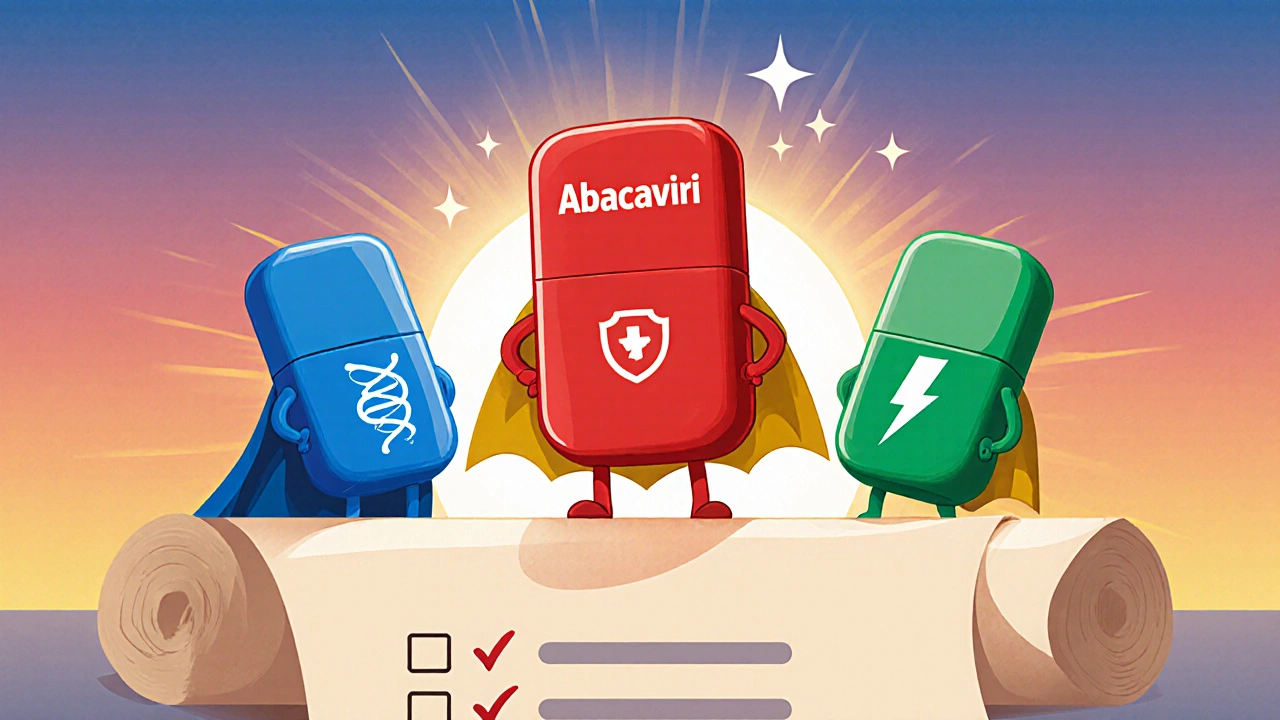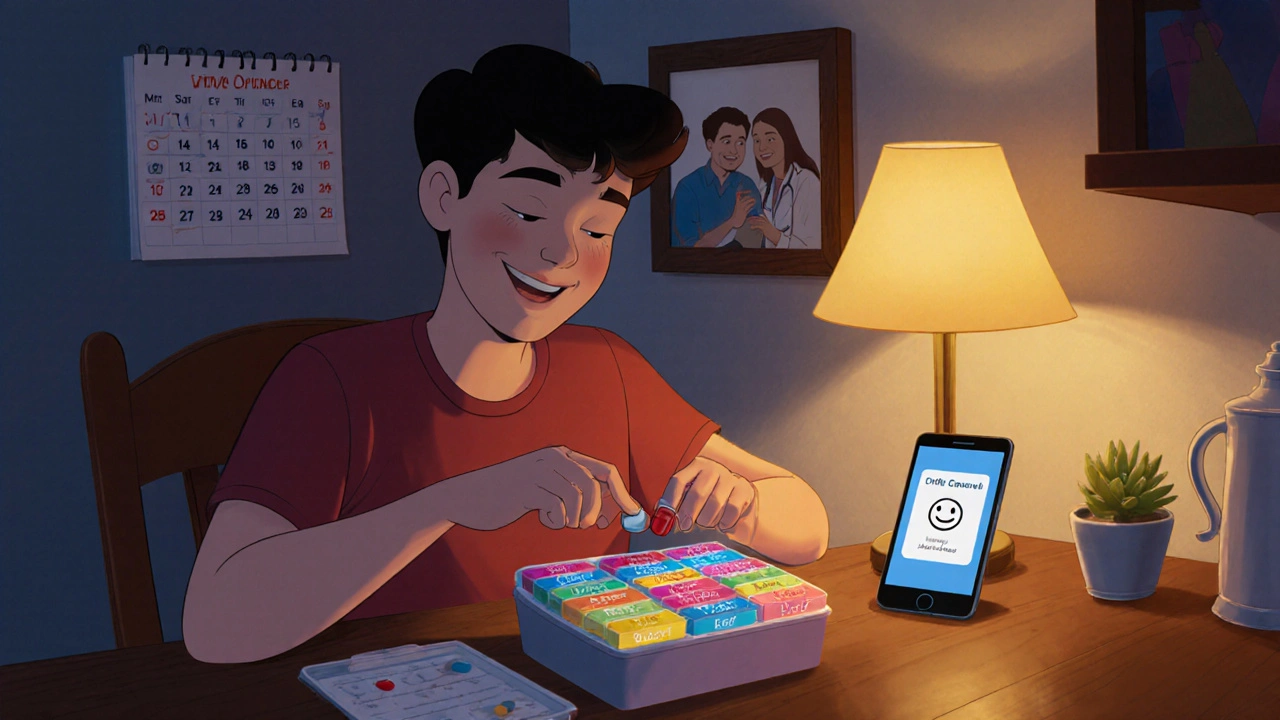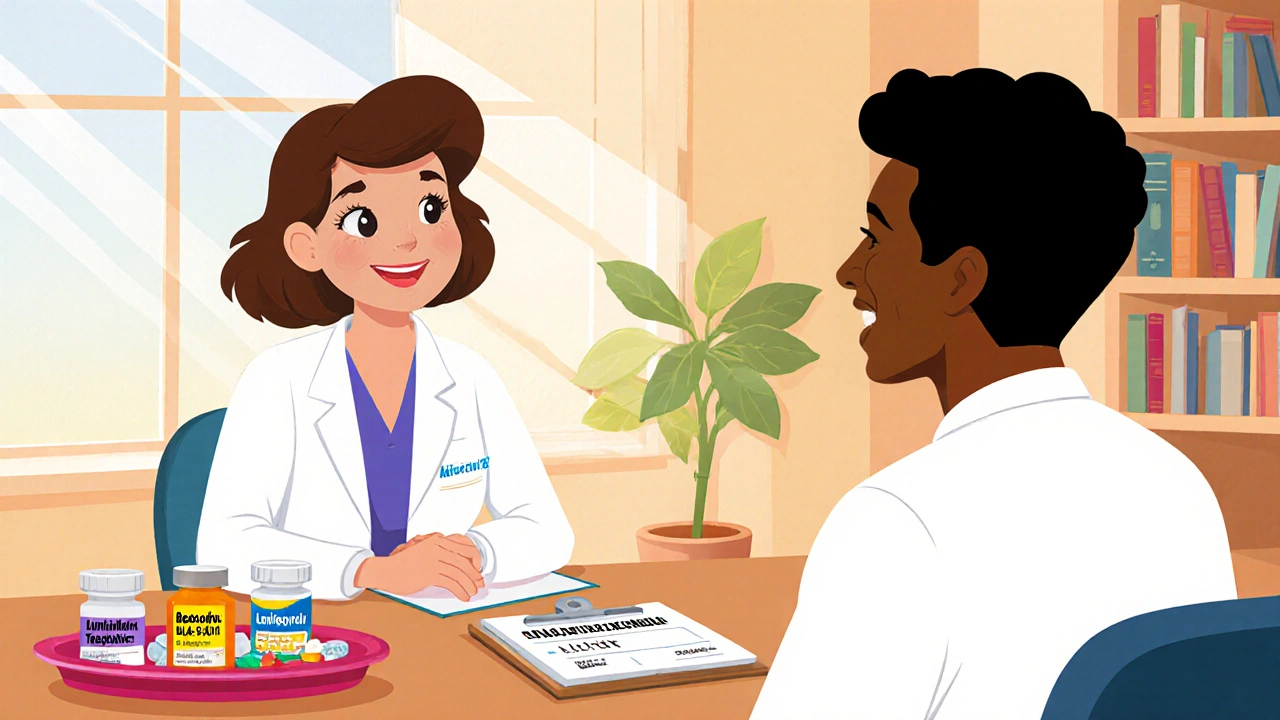Key Takeaways
- Abacavir works best when paired with other antiretrovirals that complement its strengths and cover its gaps.
- Choosing the right backbone (lamivudine, zidovudine, tenofovir) hinges on resistance profile, kidney health, and patient lifestyle.
- Adherence, drug-drug interactions, and genetic screening for HLA‑B*57:01 are non‑negotiable steps to keep the regimen safe.
- Regular viral load checks and monitoring for hypersensitivity reactions catch problems early.
- A simple checklist can turn a complex prescription into a manageable daily routine.
What is Abacavir?
Abacavir is a nucleoside reverse‑transcriptase inhibitor (NRTI) that blocks HIV‑1 replication by incorporating into viral DNA and causing chain termination. Approved by the FDA in 1998, it is often branded as Ziagen. Because it has a favorable dosing schedule-once‑daily 600 mg tablets-and a relatively low lipid profile, many clinicians favor it as part of first‑line therapy. However, its safety hinges on a single genetic test and its effectiveness spikes when it’s combined with complementary drugs.
Human Immunodeficiency Virus (HIV) the retrovirus that attacks CD4+ T‑cells, leading to immune deficiency if untreated remains a lifelong challenge, and a single drug cannot keep it in check.
Why Combine Abacavir with Other Agents?
HIV is a moving target. Using a single drug lets the virus mutate and become resistant within weeks. Combination therapy, or combination therapy the practice of prescribing two or more antiretroviral agents that act on different steps of the HIV life‑cycle, raises the genetic barrier to resistance and delivers a stronger, more durable viral suppression.
Abacavir’s strengths-good tolerability, low impact on lipids, and once‑daily dosing-pair well with drugs that cover its weak points, such as a lower barrier to resistance compared with newer agents and a rare but serious hypersensitivity reaction.
Core Backbones: Which NRTIs Pair Best with Abacavir?
Guidelines from the World Health Organization (WHO) the UN agency that sets global HIV treatment standards list three common backbones that sit alongside abacavir:
- Lamivudine a well‑tolerated NRTI with a high genetic barrier (often abbreviated 3TC).
- Zidovudine an older NRTI that remains effective against many resistant strains (AZT).
- Tenofovir disoproxil fumarate (TDF) a nucleotide analogue with strong renal safety monitoring requirements (often paired with emtricitabine).
Choosing among them depends on the patient’s renal function, hepatitis B status, and any prior resistance mutations.

Popular Abacavir‑Based Regimens
| Regimen | Pill Burden (per day) | Resistance Barrier | Renal Impact | Cardiovascular Risk |
|---|---|---|---|---|
| Abacavir + Lamivudine + Dolutegravir | 1 tablet + 1 tablet + 1 tablet | High (integrase inhibitor + 2 NRTIs) | Low | Neutral |
| Abacavir + Zidovudine + Lopinavir/ritonavir | 2 tablets + 2 capsules | Moderate (protease inhibitor + 2 NRTIs) | Low‑moderate (depends on zidovudine dose) | Potential increase (protease inhibitor) |
| Abacavir + Tenofovir + Emtricitabine + Rilpivirine | 1 tablet + 1 tablet + 1 tablet + 1 tablet | High (NNRTI + 2 NRTIs) | Moderate (tenofovir‑related renal monitoring) | Neutral |
Each line balances convenience, side‑effect profile, and resistance coverage. For most treatment‑naïve adults without renal concerns, the abacavir + lamivudine + dolutegravir combo is the current gold standard.
Maximizing Effectiveness: Practical Steps
1. Genetic Screening for HLA‑B*57:01
Before starting abacavir, test for the HLA‑B*57:01 allele. Carriers have a >50 % chance of developing a potentially fatal hypersensitivity reaction. Guidelines advise a simple PCR‑based test; a negative result clears the way for therapy.
2. Adherence Coaching
Even a single missed dose can let the virus rebound. Use pillboxes, mobile reminders, or long‑acting injectables for patients who struggle with daily oral meds. Studies from 2023 - 2024 show that adherence rates above 95 % keep viral load <50 copies/mL in >90 % of patients.
3. Drug‑Drug Interaction Checks
Abacavir is metabolized primarily by glucuronidation, so it has few CYP interactions. However, co‑administration with Ritonavir a potent CYP3A4 inhibitor used in many protease‑inhibitor boosters can raise levels of some NRTIs, requiring dose adjustments. Always run a thorough medication reconciliation at each visit.
4. Monitoring Renal and Hepatic Function
While abacavir itself is not nephrotoxic, the accompanying NRTI may be. Check serum creatinine and eGFR every 3-6 months when tenofovir is in the mix; for zidovudine‑based regimens, monitor hemoglobin for anemia.
5. Managing Cardiovascular Risk
Abacavir has been linked in some observational studies to increased myocardial infarction risk, especially in patients with existing heart disease. The American Heart Association (AHA) the US professional society for cardiovascular health advises a baseline lipid panel and lifestyle counseling. If risk is high, consider switching to a tenofovir‑based backbone.
6. Pediatric Considerations
For children over 3 years old, weight‑based dosing of abacavir (8 mg/kg) is standard. The same HLA‑B*57:01 test applies, and fixed‑dose combos like abacavir/lamivudine are available as chewable tablets. Monitor growth charts alongside viral load to ensure both virologic and developmental health.
Monitoring Outcomes
Effective combination therapy shows three clear markers within the first 24 weeks:
- Viral load drops below 50 copies/mL in 85-90 % of patients.
- CD4 count rises by at least 50 cells/µL, indicating immune recovery.
- Absence of Grade 3-4 adverse events on routine labs.
If any of these targets miss the mark, re‑evaluate adherence, resistance testing, and potential drug-drug interactions.

Practical Checklist for Clinicians
- Order HLA‑B*57:01 test before the first abacavir prescription.
- Select backbone based on renal function (eGFR > 60 mL/min for tenofovir) and hepatitis B status.
- Educate patients on the importance of daily dosing and set up reminder tools.
- Schedule viral load testing at weeks 4, 12, 24, then every 3-6 months.
- Review concomitant meds for interactions with protease inhibitors or NNRTIs.
- Document any cutaneous or systemic hypersensitivity signs within the first 2 weeks.
Frequently Asked Questions
Can I take abacavir if I have a kidney problem?
Abacavir itself is safe for the kidneys, but the companion NRTI matters. If you need tenofovir, your doctor will monitor kidney function closely. In many cases, switching to a lamivudine‑based backbone avoids renal concerns.
Do I need to avoid alcohol while on abacavir?
Moderate alcohol isn’t a direct interaction, but heavy drinking can affect adherence and liver health. Keep alcohol consumption within recommended limits and never skip a dose because of a hangover.
What should I do if I develop a rash after starting abacavir?
Stop the medication immediately and call your healthcare provider. A rash could be the early sign of hypersensitivity, which can progress to fever, malaise, or organ involvement. Prompt discontinuation is life‑saving.
Is once‑daily dosing enough for viral suppression?
When paired with a potent anchor drug like dolutegravir, once‑daily abacavir maintains suppressive levels in >95 % of patients who stay adherent. Skipping doses, however, quickly reduces efficacy.
How often should I get my HLA‑B*57:01 test repeated?
The test is done once before the first dose. A negative result stays valid for life, so no repeat testing is needed unless a lab error is suspected.
Next Steps for Patients and Providers
Start with a baseline assessment-viral load, CD4 count, renal and hepatic labs, and HLA‑B*57:01 screening. Choose the backbone that fits the patient’s comorbidities, then schedule follow‑up visits at weeks 4 and 12 to confirm suppression. Use the checklist above to keep every step in view, and don’t hesitate to adjust the regimen if resistance emerges or side effects arise.
When you treat HIV with a well‑crafted abacavir‑based combination, you give patients a therapy that’s easy to take, broadly effective, and adaptable to many clinical scenarios. The key is pairing the right partners, monitoring closely, and keeping adherence front‑and‑center.


Jennifer Stubbs
October 24, 2025 AT 22:34Combining abacavir with a high‑barrier NRTI like dolutegravir is crucial for maintaining viral suppression.
Both drugs share once‑daily dosing, which simplifies adherence for most patients.
The guide correctly flags HLA‑B*57:01 testing, but it glosses over the cost and accessibility issues in low‑resource settings.
Renal monitoring is emphasized for tenofovir backbones, yet the same vigilance should apply to zidovudine‑induced anemia.
Overall, the checklist approach is useful, but clinicians need more real‑world data on cardiovascular risk.
Abhinav B.
October 26, 2025 AT 20:33Listen, the Indian crowd loves a solid combo that doesn’t break the bank, so pairing abacavir with lamivudine and dolutegravir is the smart move.
Don’t let the guide’s polite tone fool you – you must *force* HLA testing before the first pill, otherwise you’re flirting with a deadly rash.
Also, forget the hype about tenofovir safety; many patients in rural clinics can’t get regular eGFR labs, so stick with the cheaper AZT‑based regimens.
And yes, the “once‑daily” claim is only true if the patient can actually remember to take it – maybe use a phone alarm.
Abby W
October 28, 2025 AT 18:31Hey @Abhinav, you’re dropping truth bombs but let’s keep it friendly 😅.
Honestly, the HLA‑B*57:01 gatekeeping is a lifesaver, and a simple emoji reminder on the pillbox can save someone from a hypersensitivity nightmare.
Also, mixing cultural references with dosing schedules is cute, but the real drama lies in getting patients to *actually* open their meds every morning.
🚀 Stay sharp and keep those emojis rolling!
krishna chegireddy
October 30, 2025 AT 16:30While most clinicians trust mainstream guidelines, the hidden agenda is that pharma pushes dolutegravir because it’s patented.
Simple logic: a cheap NRTI backbone paired with an expensive integrase inhibitor guarantees higher profit margins.
Even the “cardiovascular risk” paragraph feels like a smoke screen – the data are inconclusive, yet the warning stays to keep doctors cautious.
Stick to the basics: abacavir + lamivudine works fine without the fancy add‑on.
Max Lilleyman
November 1, 2025 AT 14:28Great checklist, looks solid! 👍
Buddy Bryan
November 3, 2025 AT 12:26When you’re dealing with a chronic infection like HIV, the first rule is to never let a single drug bear the entire suppressive load.
Start by confirming the HLA‑B*57:01 status; a negative result eliminates the hypersensitivity specter and lets you move forward confidently.
Next, assess renal function: if eGFR is above 60 mL/min, tenofovir becomes an option, otherwise prefer lamivudine or zidovudine, each with its own monitoring schedule.
For most treatment‑naïve adults, the abacavir + lamivudine + dolutegravir triple offers a high genetic barrier, low pill burden, and minimal lipid impact.
Adherence remains the linchpin – studies from 2023 show that patients missing more than one dose per month experience a 20 % increase in viral rebound risk.
Implement reminder tools: phone alarms, pill organizers, or even one‑month blister packs that visually reinforce daily dosing.
Don’t forget drug‑drug interactions; while abacavir itself is low‑CYP, boosters like ritonavir can inflate levels of co‑administered NRTIs, necessitating dose tweaks.
Regular labs are non‑negotiable: check serum creatinine and eGFR every three to six months when tenofovir is present, and monitor hemoglobin if zidovudine is used.
Cardiovascular assessment should include baseline lipid panels and, for high‑risk patients, consider swapping abacavir for a tenofovir‑based backbone.
In pediatric cases, weight‑based dosing (8 mg/kg) and chewable fixed‑dose combos simplify administration, but the HLA test still applies.
Finally, track outcomes: a viral load <50 copies/mL, CD4 rise of >50 cells/µL, and absence of grade 3‑4 adverse events by week 24 signal a successful regimen.
If any of these fail, revisit adherence counseling, resistance testing, or potential drug interactions before making drastic changes.
This systematic approach maximizes effectiveness while keeping safety front‑and‑center.
Amber Lintner
November 5, 2025 AT 10:25Oh, please! Buddy’s “systematic approach” reads like a textbook you’d find in a museum.
If you wanted drama, just watch a patient forget their pills for a week – the virus will throw a party and you’ll be left cleaning up the mess.
Maybe skip the eight‑paragraph sermon and hand them a simple one‑page cheat sheet. Real life isn’t a PowerPoint.
Lennox Anoff
November 7, 2025 AT 08:23It is morally reprehensible to ignore the socioeconomic barriers that prevent many from accessing HLA testing and regular monitoring.
We must champion a public‑health model that subsidizes genetic screening and ensures labs are available in underserved neighborhoods.
Only then can we claim to practice ethical HIV care, rather than perpetuating a system that favors the privileged.
Olivia Harrison
November 9, 2025 AT 06:21I hear you, Lennox, and I completely agree – equitable access is a cornerstone of good medicine.
Many clinics already use rapid point‑of‑care HLA tests that can be funded through community grants.
Sharing those resources and training staff on proper monitoring can make a huge difference for patients who otherwise fall through the cracks.
Bianca Larasati
November 11, 2025 AT 04:20Let’s fire up the motivation! 🎉
Every dose of abacavir taken on schedule is a victory against the virus – celebrate those small wins.
Set a daily alarm, reward yourself with a coffee after you’ve taken your meds, and keep your health goals front and center.
Remember, consistency beats perfection; keep moving forward!
Corrine Johnson
November 13, 2025 AT 02:18Indeed, motivation is the engine of adherence; however, one must contemplate the existential weight of daily pill burdens - does the ritual of ingestion not echo the Sisyphean task of humanity?
Zaria Williams
November 15, 2025 AT 00:16You guys keep talking like you’re the only ones who know the game, but real patients just want a simple plan.
All this fancy talk about backbones and barriers makes my head spin.
ram kumar
November 16, 2025 AT 22:15Honestly, Zaria, it’s not that complicated – just pick a NRTI combo that’s cheap and you’re done.
All the extra monitoring feels like a conspiracy to keep pharma profits high.
Melanie Vargas
November 18, 2025 AT 20:13Hey everyone, remember that community support groups can be a game‑changer for staying on track 😊.
Sharing experiences, tips on reminders, and even holding each other accountable makes the journey less lonely.
Deborah Galloway
November 20, 2025 AT 18:11Thanks, Melanie! Your reminder about support groups is spot on – having a friendly ear really boosts confidence and adherence.